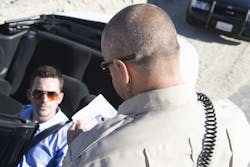How Can eCitation Benefit Officer Safety?
By RAD DeRose, President & CEO of L-Tron Corporation
Traffic-related incidents have been the leading cause of law enforcement line-of-duty deaths (LODDs) for many years. Though many measures have been put in place to mitigate this dramatic threat to officers’ life and safety, could more be done to promote scene safety while performing traffic stops?
According to 2011 International Association of Chiefs of Police (IACP) Division of State and Provincial Police (S&P) research entitled, “Preventing Traffic-Related Line-of-Duty Deaths,” law enforcement officers are four times more likely to be involved in a traffic collision than the average civilian motorist1. In fact, 150 law enforcement officers were killed between 2000-2009, as a direct result of traffic-related incidents (60% of all officer deaths in that time period).
Forty-two percent of those fatal traffic incidents involved officers being struck on the side of the road.
With officer safety perpetually on the minds of department leadership, what else can be done to promote officer safety?
Of the strides made within the past few years, road-side safety programs have driven improvements to increase the conspicuity of vehicles and officers (reflective markings and clothing, more emergency lighting, improved on-scene vehicle positioning, etc.), encourage passing motorists to move over and/or slow down, and train law enforcement personnel safer methods for approaching traffic stops and assessing scene safety.
These measures, while important, do not solve the larger issue; traffic stops are inherently one of the most dangerous tasks any law enforcement officer performs on a day-to-day basis. Though we cannot effectively eliminate the danger, one additional approach an agency can take to promote officer safety while performing traffic stops is to use automated technology solutions that shorten the amount of time necessary to perform a traffic stop.
The idea is simple: if you reduce the amount of time necessary to complete a traffic stop, you reduce the level of vulnerability officers are subjected to on the side of the road. These technologies result in less time on the side of the road, directly impacting the number of LODDs experienced in law enforcement and providing a variety of other system improvements (to learn more about specific automated technologies and the return-on-investment experienced by one department in Pennsylvania, check out L-Tron Corporation’s upcoming case study: “Put Down the Pen & Paper: eCitiation to the Rescue”).
Automation and the use of database information to populate fields on a citation, for example, can save officers a significant amount of time when issuing citations (it takes approximately ¼ of the time to complete an eCitation when compared to manual processing); this advancement can also improve records management accuracy and promote increased situational awareness. By letting a computer and other automated technology solutions (area-imaging scanners, in-vehicle printers, etc.) do the work, the officer can focus on critical elements of scene safety and maintain a heightened level of awareness.
What potential impact could systems automation such as eCitation have on your operations?
For more information and expert advice on how to leverage automated technology to mitigate staffing challenges, drive ROI and immediate cost savings, and experience vital time-savings, contact L-Tron Corporation at 800-830-9523. We’ll work with you to provide a comprehensive, end-to-end plan to refresh your agency’s technology based on your current needs and budget constraints. You don’t have time to waste!
----------------
Recommended: To learn more about how e-ticketing and automated systems have improved citations, offering law enforcement agencies more time to patrol communities and keep citizens safe, read "From Pen & Paper to Cloud Based Data Management" and stay tuned for future case studies from L-Tron Corporation.
About the author:
RAD DeRose is the President & CEO of L-Tron Corporation. He has over 30 years of experience in industrial automation and data collection solutions and brings a deep industry knowledge-base on the challenges faced in the commercial and public safety sectors.
1Source: http://www.theiacp.org/Portals/0/pdfs/Traffic-RelatedLODReport.pdf
